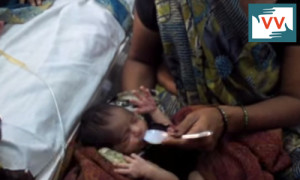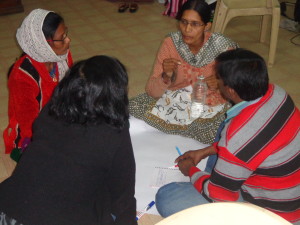Each year, approximately 56,000 women in India die in childbirth – a staggering number. This is particularly horrifying because today, no women need die in childbirth. Nearly every single one of these deaths could have been prevented - had the women received the medical care they are entitled to by law.
 What changed because of all these deaths? Who went to jail? What new laws were passed? Which doctors were fired? What kind of a national emergency did the government declare regarding these deaths? Perhaps there were consequences in some of these cases, perhaps some people were held accountable. But from reading the news reports, you would never know.When so many women die, none of them are a news story. As UNICEF says, "the tragic reality is that too often maternal deaths are not visible. They don't leave any trace behind, and their deaths are not accounted for."
What changed because of all these deaths? Who went to jail? What new laws were passed? Which doctors were fired? What kind of a national emergency did the government declare regarding these deaths? Perhaps there were consequences in some of these cases, perhaps some people were held accountable. But from reading the news reports, you would never know.When so many women die, none of them are a news story. As UNICEF says, "the tragic reality is that too often maternal deaths are not visible. They don't leave any trace behind, and their deaths are not accounted for."
India has one of the highest maternal deaths in the world; despite this, the coverage has been scant. Now that the uproar after the sterilization deaths in Chhattisgarh has died down, the condition of mothers and newborns in India has gone off the radar again. That’s why Video Volunteers, with the support and partnership of Oxfam India, has launched a project on maternal health reporting. As Manish Kumar, VV’s chief Video Trainer told our Community Correspondents during their training, “Nothing can be done to bring back these 56,000 women, but we can prevent more such cases from taking place. Because the key to preventing these deaths is here in our villages: it all starts by making sure our neighbors get the services and entitlements they deserve, and this is something within your power as Correspondents. We can make our Anganwadis function better. We can get great Auxiliary Nurse Midwives working in our villages. We can make Block and District level hospitals deliver the services they ought to.”
Manish has a personal connection to this issue – his first child died in childbirth, because the local hospital wasn’t equipped to handle a complicated birth. Other Community Correspondents at the maternal health training in Raipur, Chhattisgarh, shared their personal experiences of the conditions in their villages. All the stories amply illustrated the social problems and access problems that lead to maternal health complications.
 Reena Ramteke, an empowered Community Correspondent from Chhattisgarh, who has recently been made Councilor at the District Level, got very emotional, talking about how when she was growing up the women were told to take traditional remedies rather than go to the doctor. “We are totally dependent on men for medical care. We women can’t just go to the doctor. The doctor is far away. We need money
Reena Ramteke, an empowered Community Correspondent from Chhattisgarh, who has recently been made Councilor at the District Level, got very emotional, talking about how when she was growing up the women were told to take traditional remedies rather than go to the doctor. “We are totally dependent on men for medical care. We women can’t just go to the doctor. The doctor is far away. We need money the bus. Definitely, men go to the doctor more often then women.” Lack of autonomy over their wages leads to lack of control over their health care choices. Another woman shared how little respect people have for women’s health, whether it is an insensitive front line worker or someone in their own family. “Sometimes the mothers-in-law will say, “‘pregnancy is simple. Why would you need to go to a hospital? I gave birth to ten children and nothing happened to me!’”
the bus. Definitely, men go to the doctor more often then women.” Lack of autonomy over their wages leads to lack of control over their health care choices. Another woman shared how little respect people have for women’s health, whether it is an insensitive front line worker or someone in their own family. “Sometimes the mothers-in-law will say, “‘pregnancy is simple. Why would you need to go to a hospital? I gave birth to ten children and nothing happened to me!’”
Two of the male Community Correspondents shared how their wives had given birth at home, with a midwife, but stated this is happening less now. They shared that while home births may have reduced, thanks to government programs that incentivize deliveries in hospitals, the care women get during pregnancy and at the hospitals is often very poor. “Women go to the doctor only for a pregnancy test and then sterilization. Most of the routine pregnancy check-ups – they aren’t happening in my village. Besides this there is the cost. The government hospitals are so bad that private hospitals are the only option. But who can afford that?”
VV Correspondents have been covering maternal health issues since 2010, with about 35 reports done to date— including on lack of services for deliveries at night; lack of ambulances in villages; women not being provided medical care at hospitals right after delivery; and the absence of Auxilliary Nurse Midwives or doctors at health centers. Many have also brought change through their videos. For instance, Sunita Kasera succeeded in improving delivery of iron tablets for pregnant women in her village; Saroj Paraste’s video held accountable an absentee nurse-midwife thus bringing better care to 295 women.
Community Correspondent Mukesh has been working tirelessly on a case of extreme medical negligence – AmnaBibi, a young mother, was made to wait for three hours at the hospital she was assigned to deliver at. Her family eventually had to hire a taxi to get to a non-government clinic where her child was born dead because of the delay. VV is supporting Amna in getting her compensation for her loss and in getting the negligent doctors fired. Though the latter hasn’t happened yet, Mukesh says that the services have improved after being highlighted in the whole state of Jharkhand.
In the current project with Oxfam India, VV is training Community Correspondents in four states – Jharkhand, Orissa, Bihar and Chhattisgarh – to report on the issues of maternal health. They will be video-monitoring the government programs benefiting pregnant women (such as the National Rural Health Mission, the Integrated Child Development Services, and the Public Distribution System) and working to get redressal wherever they see a gap. We will advocate alongside Oxfam India’s extraordinary maternal health program – which has, among other things, activated 420 Village Health and Sanitation Committees to monitor local-level health services. By the end of this year, we will have trained 100 CC’s on this issue from across India. They will highlight the injustice visited on these 56,000 women who died last year, turning them from a statistic into a person whose voice and story matters, even from the grave.
Fighting for Change: The Story of Bihar-Based Journalist Amir Abbas
Inspiration can come from many sources, but one of the most powerful is seeing someone walk the path before you. Our Community Correspondent, Syed Amir Abbas found his inspiration in Stalin K., the founding director of Video Volunteers. “I met Stalin at VV’s national meet in 2017 and I...
The Positive Changes in a Primary Health Centre
The positive changes in one of the Primary Health Centre (PHC) in Ramgarh District is encouraging.
